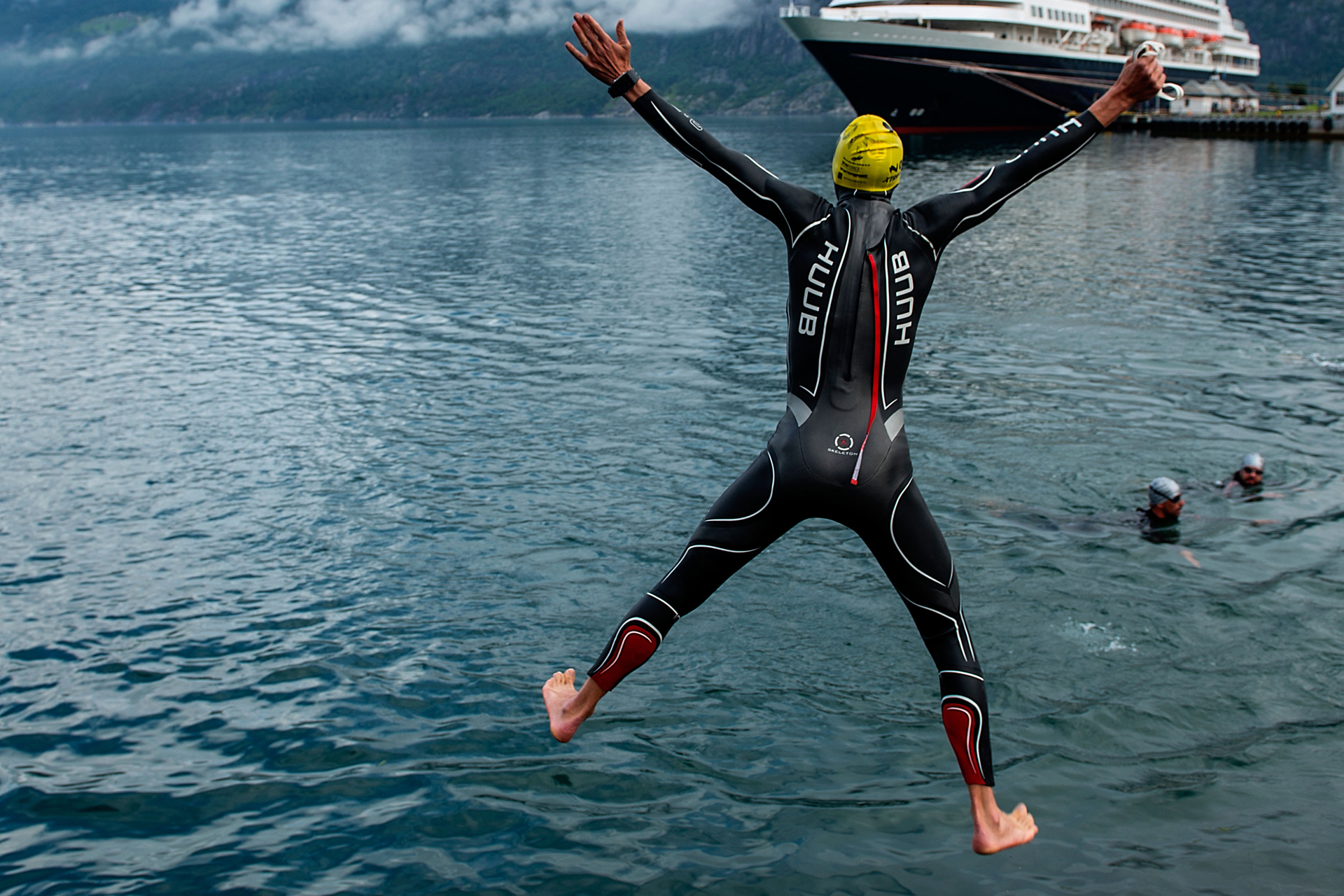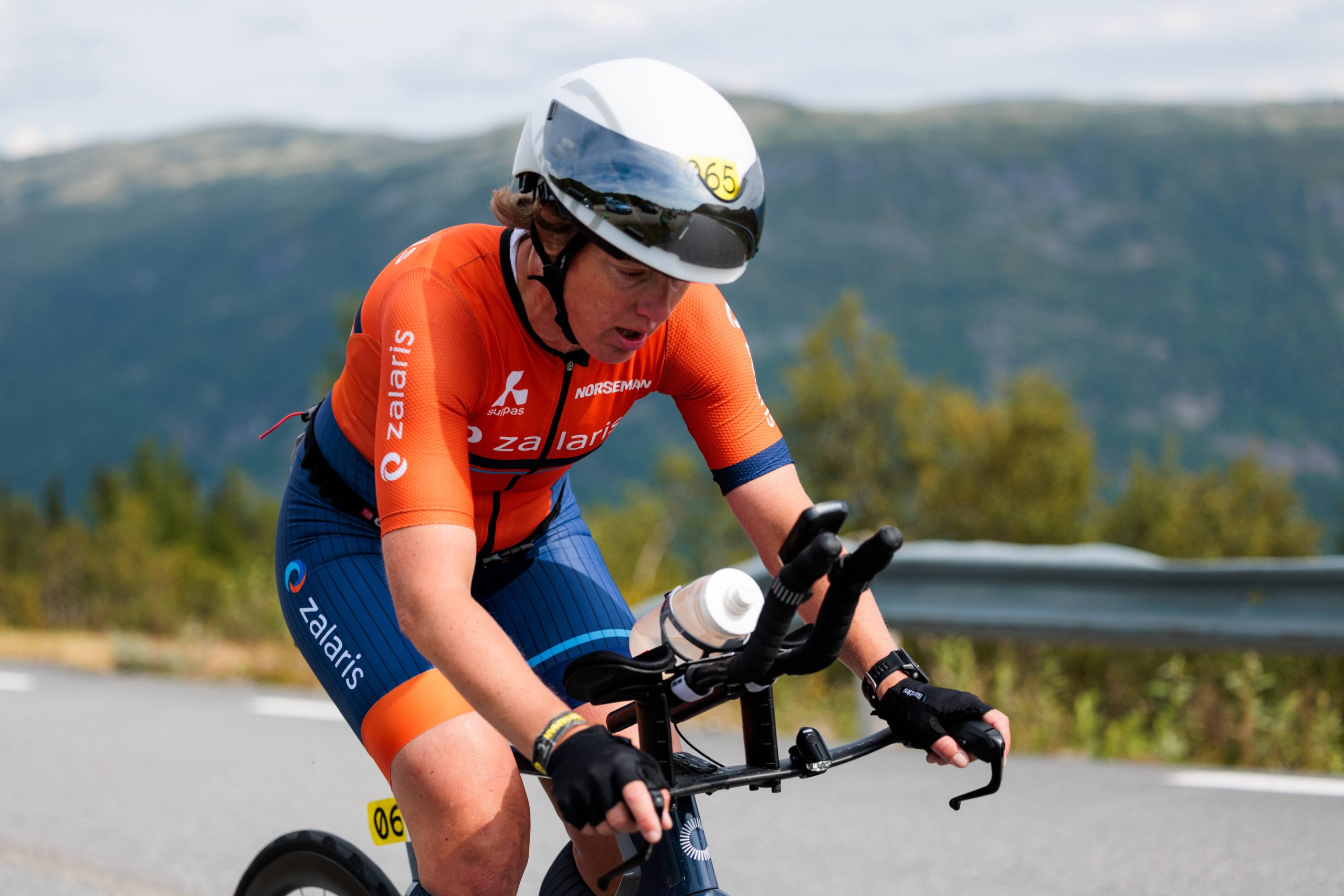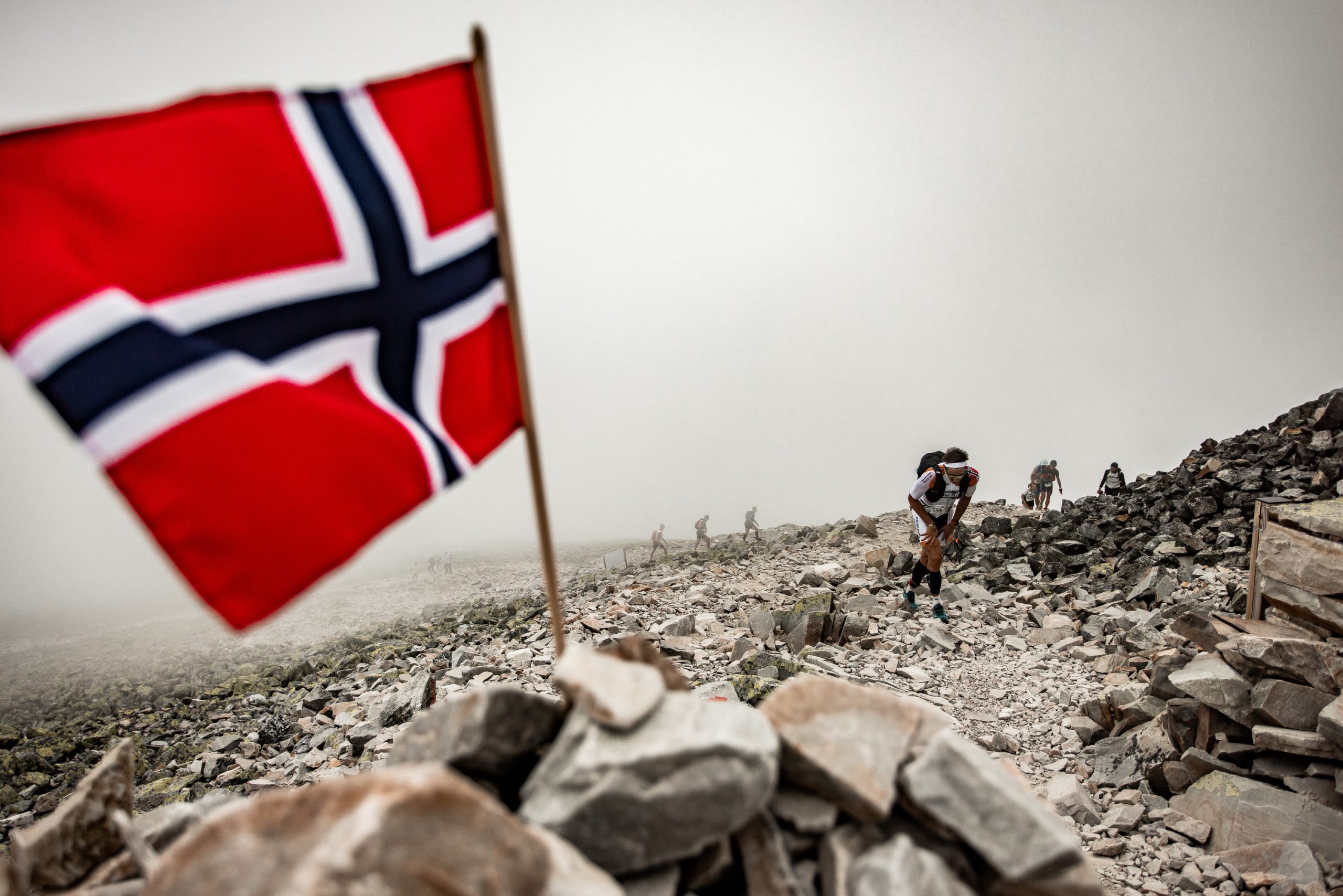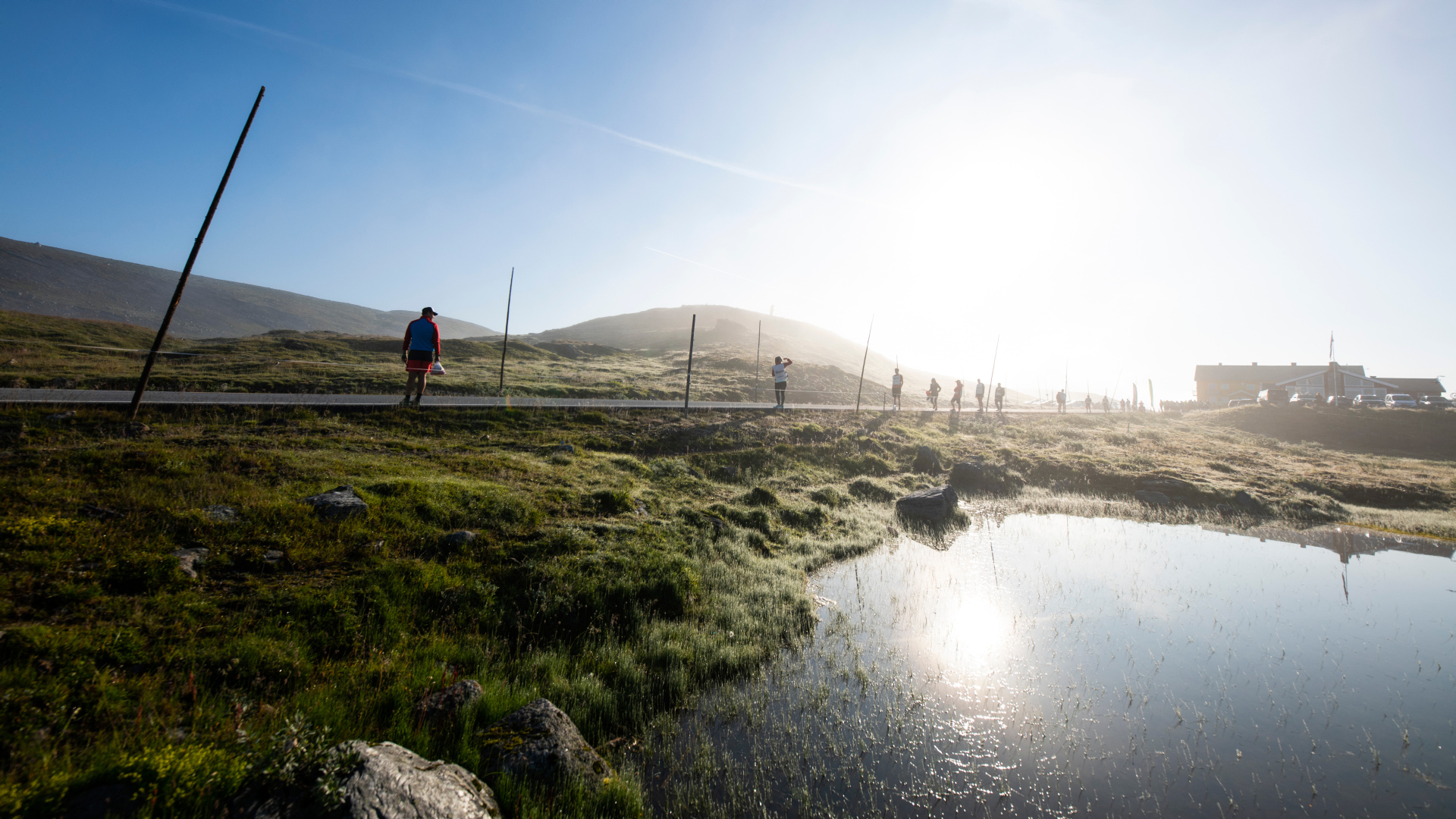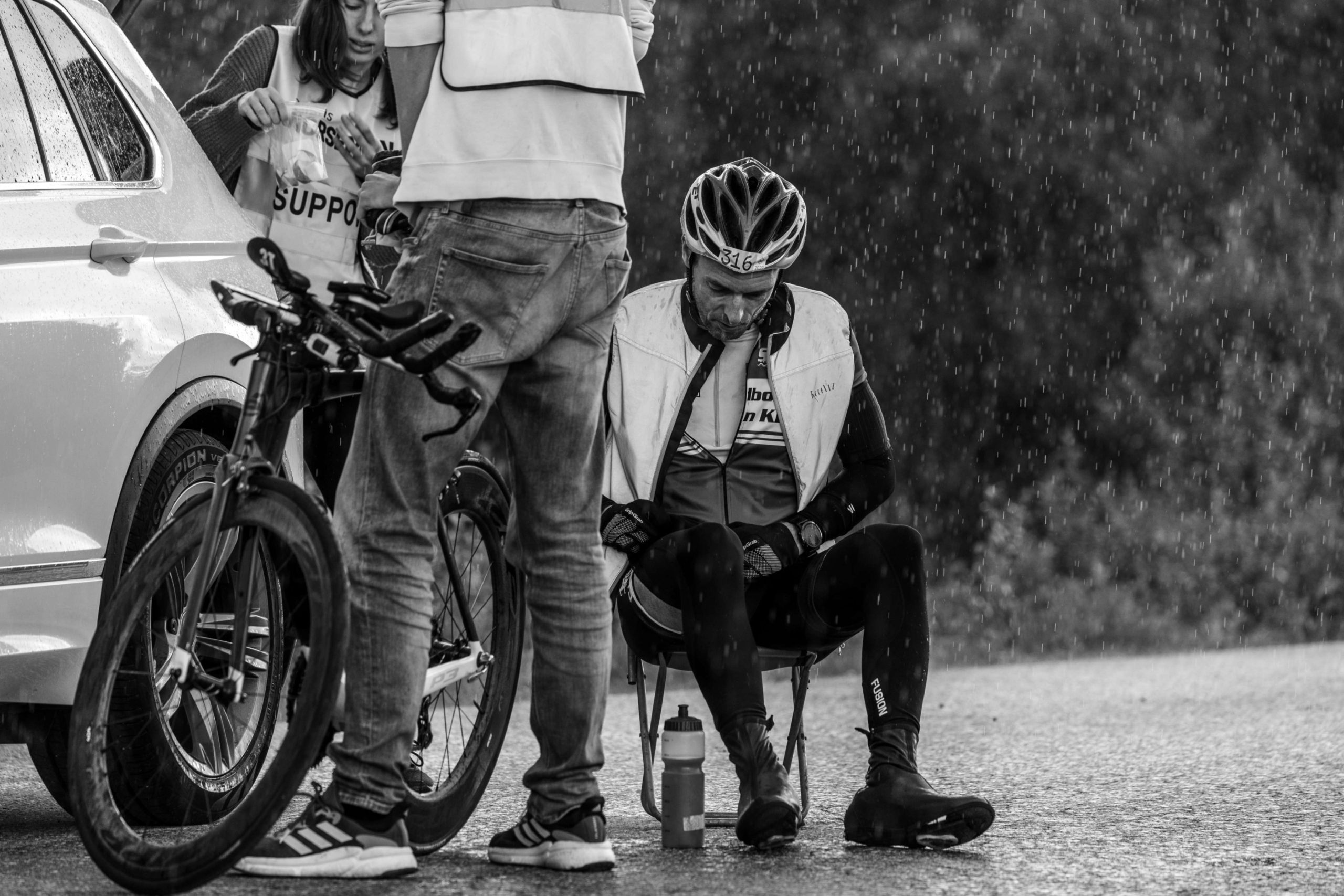In this post we have taken a closer look at how to make open water swimming safer and more enjoyable. We are also introducing The Norseman Swim Code. One page and eight bullet points to safer swimming.
The video below has also been transcribed further down. Images and relevant links has been added.
Helen: Hello, and welcome to the first in a series of special Norseman Live videos, designed to keep you entertained and motivated during this difficult year. I’m Helen Webster from 220Triathlon and I’m joined today by Norseman’s fantastic panel of experts to talk about open water swimming.
Now, across the world, we’re all fighting hard at the moment to keep our loved ones and communities safe from coronavirus, which has meant some really big changes to how we train and race. Of course, we’re very disappointed not to be swimming together in Eidfjord this summer.
But on a positive note, we have longer to prepare and train for 2021 race. So joining me today are Jørgen Melau, Chief of Medical Crew for Norseman, and Dean Jackson, Founder and Director of HUUB Design.
So Jørgen, let me come to you first. Globally we’re in various stages of lockdown at the moment, and I know here in the UK, we’re not able to swim at the moment, but what’s the situation with swimming in Norway where you are?
Jørgen: Well, in Norway, all the swimming pools are closed at the moment, and we do not know when they will open again. We can swim outdoors and there are a lot of creative solutions in private hot tubs and backyard pools. I just saw one of the Norwegian elite triathletes, Gustav Iden, was on the national news a few days ago, swimming in a hot tub with a rope attached around his waist.
Swimming in open water, however, is allowed, but it is still a bit too cold. Here with me, the sea temperature is about nine degrees Celsius, which is about 48 degrees Fahrenheit. I have learned to convert the temperature in my head, because I use my brains around temperatures all day now. But outdoor swimming is allowed, but still a bit too cold.
But as these lockdowns start to lift during the summer, I know we’re all going to be desperate to start swimming in open water again. I know that I am. What should people’s primary considerations be, before they just rush out there and start swimming again?
I know, I’m so keen to go out swimming myself. I just love open water swimming. We get a lot of questions about this, which is a good thing actually, since we in the Norseman team have lots of experience with this now.
And that is why we have worked on making the Norseman swim code, which I will come back to a bit later. But at the moment, the major concern is the corona situation. And regarding swimming, there are no specific corona considerations to handling the open water swimming. And that is, you should certainly follow the guidelines from the health authorities, which is very important. So you should follow the guidelines from your local health authorities.
Helen: Yeah, of course. And certainly here in the UK, we’re hoping for some more input from the government about how we move out of lockdown and what the safety is around returning to exercise and swimming. But probably the first thing that people will worry about when going to open water is the temperature. Jørgen, just tell us a little bit about the temperatures involved in open water swimming and the implications on safety.
Jørgen: Well, we now advise quite clearly that we do not recommend any swimming with a wetsuit below 12 degrees water temperature. And for such low water temperatures, you probably should have a shorter swim. For several people, it should probably, A, it’s probably wise to have a much higher water temperature than 12 degrees anyhow.
The reason we can give this advice now is that we have done studies on this, which was published about a year ago. As you might recall, we had quite a cold swim in 2015 at Norseman. Then, the water temperature was about 10 degrees Celsius. We decided to shorten the swim that year.
And what we did a few months later was that we let 20 triathletes swim in 10 degrees water in a controlled study. And with some statistical methods, we showed that if we had done a full distance swim in 2015, almost 50% of the athletes had been suffering from hypothermia, the medical definition of hypothermia.
And that was a real eye opener for us and something that we believe is very important. I think regarding temperature, consider 12 degrees as the absolute possible lower range of possible swim temperature. And probably for most people it should be a bit more than that, before you start to swim.
Helen: And the Norseman safety team, you really are experts in open water safety. You’ve done a lot of research on this. Now you mentioned that Norseman has launched a swim code, which people can see at www.nxtri.com. And that’s designed to keep everybody safe in open water. So how can new swimmers and also experienced athletes make sure they’re staying safe?
Jørgen: Well, I think one of the most important things that we have to adopt into our open water swimming community, and I know a lot of people do it already, but I think you have to get it higher on a list of important safety measure, is that you should always have a swim buddy. Never swim alone.
I do not just mean that you train with a friend, but that you specifically look after each other when you’re out in the sea. And if you swim in a group, team up with a buddy before you start your training. Then you’ll look after each other during the swim.
Apart from that, I think that you should follow the Norseman swim code. There are a lot of very good advices there. It’s like the 10 commandments from the Bible, although it’s only eight commandments in the Norseman swim code.
Oliver had a very clever idea, and that was to build up, similar to the Norwegian mountain code. The Norwegian mountain code is something every Norwegian is raised with from childhood. It gives advices on how to stay safe in the mountains.
So the Norseman swim code is developed by us to stay safe in open water. So we will present them now, as you said, on our website just now.
Helen: Yeah, I’ve read the swim code and it’s absolutely fantastic, and I thought what was good about it was it’s so simple. So it’s kind of like a checklist of all the things you need to be aware of before you go swimming in open water, that anybody can look at, anyone can follow it. It’s really kind of clear and precise, which I just think is fantastic.
We’ve talked a lot about temperatures, but what actually happens to your body when you get in cold water?
Jørgen: Well, that is not a very easy question to answer for a scientist very shortly, but I’ll do my best. There are currently two important physiological responses that we are investigating. The first is that we are more and more aware of, is the strong activation of several branches of the nervous system.
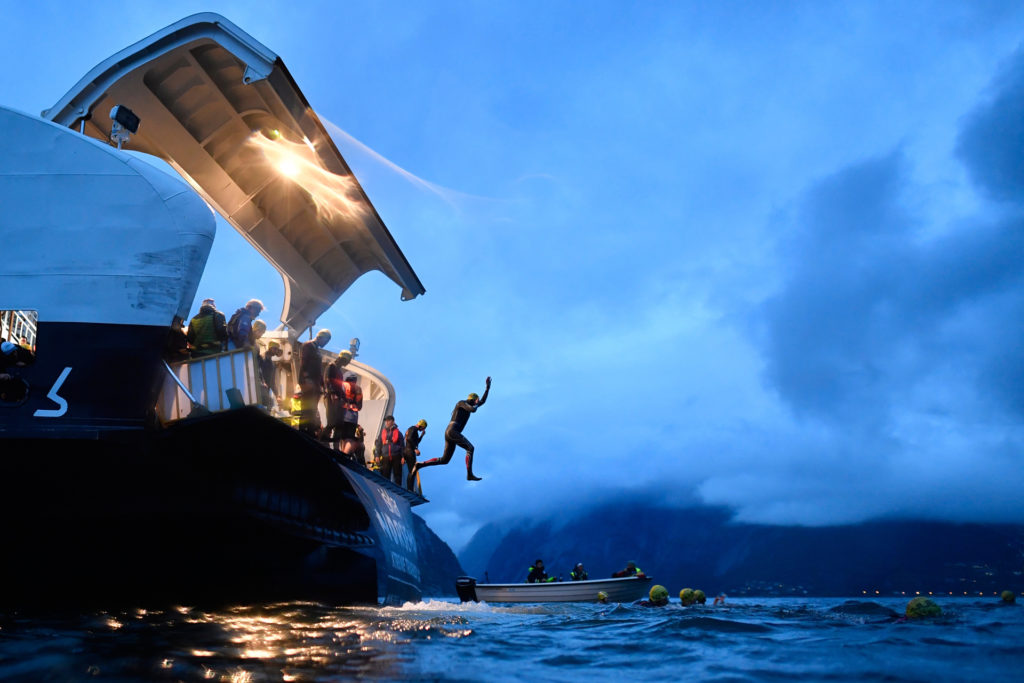
When you suddenly are hitting cold water, like when you jump from a ferry, these are strong and very powerful activation, and for some vulnerable people, it can be very dangerous, because it can generate arrhythmias. It’s called the autonomic conflict. If anyone is interested in googling it, there are some very, very good British scientists like Mike Tipton in Portsmouth that has done lots of research on this.
The second challenge is hypothermia, which is the cooling of the core temperature. And hypothermia can be a problem, only if the water is cold and the swim is long. However, there are huge individual variation, and that is why it’s so hard to give any exact limits. But as we just talked about, we do not recommend swimming in colder water than 12 degrees Celsius. And again, for some, it should probably be much warmer.
Helen: Okay, some good advice. Thank you. So we’re going to look at the swim code. We’re always going to swim with a buddy. We’re going to make sure the temperatures aren’t too cold for us. But the right kit can make a huge difference in open water swimming as well.
So Dean Jackson is sitting there waiting patiently from HUUB Design. This seems like a really good time to bring you into the conversation. So how can the right wetsuit help in colder water?
Deano: Yeah. Hi, Helen. Hi, Jørgen. Hello, everybody.
Equipment is vitally important, and I think it comes down to what we see in any equipment in the sport of triathlon, is something has to fit. We can have the best bike in the world, but if it doesn’t fit, it’s not going to perform.
And it’s the same with wetsuits. There are several wetsuits on the market and HUUB certainly offers several different suits and we have some that are geared more towards the colder temperatures of swimming. But key is going to be getting your fit.
When you look at what your wetsuit does, a lot of it is in the name, it’s a wetsuit, and water does get in and you can fasten your neck as tightly as you want and put rubber bands around your wrists. But please, let’s get some water in, because that actually serves as an insulator in the water that’s in the suit, to keeping you warm.
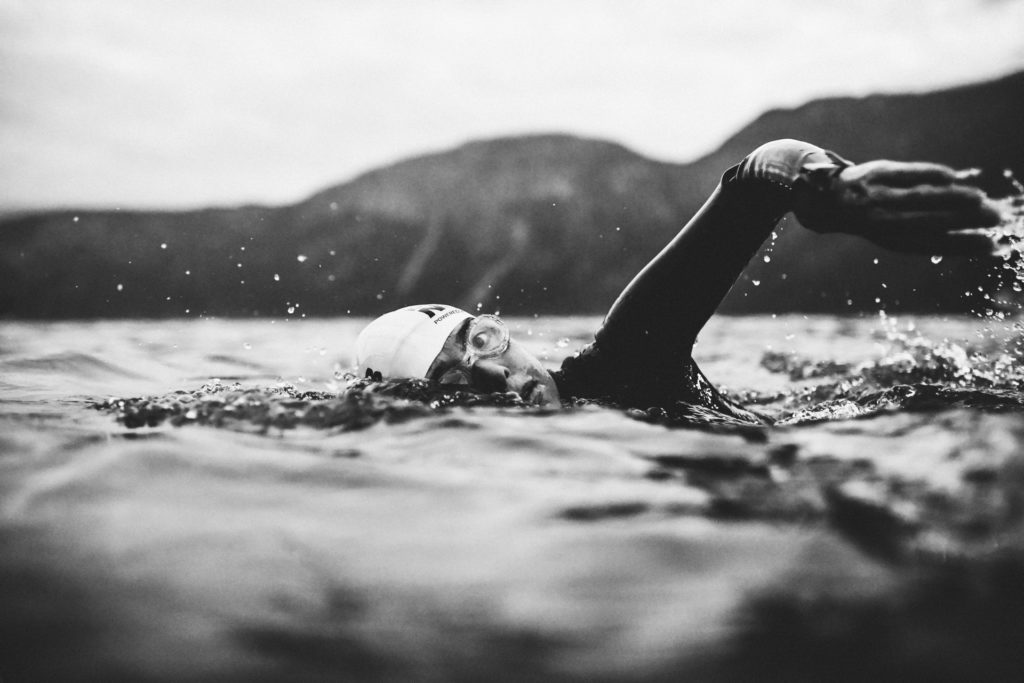
Now, if you have it too big, you may have too much water flushing through and if it’s too tight, you’re not going to have really any water coming in. So you want to make sure you get your fit right. And a lot of that is down to personal preference, also having someone expertly fit you.
And then it’s the different types of suit. We have suits with warmer linings, and the goal there is any heat that’s leaving the body that’s warming that thin layer of water up around the body is staying warm and not losing heat through the neoprene.
And then it’s the extremities. There is a belief that the majority of your heat is lost through your head. That’s not the case. It just so happens that your head doesn’t have a lot of fat insulation to keep heat in. So it’s not the best at keeping heat in.
So we previously had a skull cap, but it’s been working with Norseman and Jørgen and the team, and the knowledge that they are leading the way on this activity in cold water. And we created a new product called the Varme, which is a full balaclava that you’d put on before your suit and it sits over your head and under your shoulders. So when you actually put your wetsuit on, you have a nice seal. And it’s just allowing those key exposed areas of the body to be covered and let that little bit of water in and that will heat up.
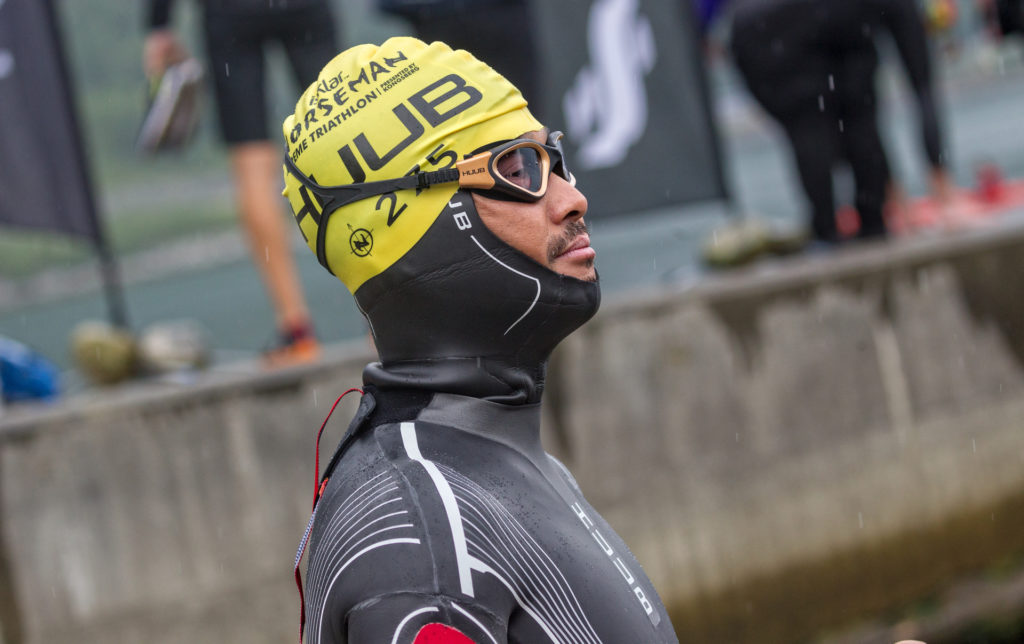
And that’s also to the extremities of swim gloves. A neoprene or a very fixed swim glove and the booties, and the booties are there to protect your feet getting into the water, but also to give, again, it’s just some extra thermal support. You are going to be generating heat while you’re swimming, but in these extreme conditions that you can experience, I dread to think, what potentially swimming in 10 degrees is like, I’ve never done it. I don’t think I ever want to. But you need to give as much protection to the body as you can. So there’s a range of things you can do.
And also down to, do you need more than a wetsuit? I’m sure there’s plenty have tried it, but if you actually have underneath your suit a very quick drying extra layer and that could be some of the great thermal layers. I wouldn’t recommend anything that’s a wool because it’s going to stay very wet for perhaps too long.
But do put another layer underneath, put a neoprene vest underneath or a high performing quick drying fabric underneath.
Helen: Yeah, I know that I certainly feel the cold very much in races. I struggle a little bit with it and you’ve kindly helped me out in the past with one of your thermal wetsuits, with the gloves and booties and fits and it makes such a difference.
Deano: Good.

Helen: But Dean, you’ve worked close with the Norseman team as well to design special gear for Norseman competitors, because Norseman is a bit different, isn’t it? So do you want to tell us a bit about those products and also how does the fitted kit differ for the Norseman than for a normal triathlon?
Deano: Yeah, it’s an ongoing thing and the beauty of Norseman is not only as a race, but everybody involved with it is so passionate and caring for the athletes that we’re constantly challenged on making the kit more applicable. At the minute we’re working on the reflective garment and the reflectiveness that’s needed throughout the race, but also bearing in mind that we need to be as aerodynamic as we can be, but we need to be as safe as we can be and get the best out of our performances.
And in the past, we looked at what happens when you leave the water. I think for a lot of athletes it’s, well, I’m out of the cold bit, which is the water and my wetsuit is off and I’ll put on my really, really thin Lycra triathlon suit and I’ll go careering down the road. I’m going to have wind effect and the temperatures are going to drop.
So one of the first products we worked on was a tri suit that had a wind resistant front, so we could keep the torso and the chest warmer for longer after T1. And it was just that thinking that’s led it into arm warmers and just thinking very differently about this unique race. And then base layers and all those bits that go around keeping you exceptionally safe throughout this challenge.
Because there’s the physiological threats that go on, but it’s also the environment that you’re in. It’s quite a unique environment, Norseman.

Helen: It really is. I’ve swam in Eidfjord and it’s beautiful, but I have to stress that I haven’t done the race. I’ve only had a nice swim with some friends and competitors there, so I haven’t done the full distance.
But Dean, one of the things I love about HUUB is you are constantly innovative as you’ve just described. And what technologies in swimming kit are you really excited about at the moment?
Deano: What I’m really excited about and Jørgen’s been helping with this is the amount of research that’s going on. Thanks to Norseman and unfortunately some mishaps in open water swimming in high heat, that now there’s a lot of research going on at the extremities of too much heat and not enough heat.
I’m really excited what’s coming out of it. We’ve created the Fellowship of Speed and this is bringing together some of the best experts be it in swimming or cycling or running, but saying here’s a challenge, and one of those has been around cold water swimming. But I think what is exciting, I’m not sure how close it is and whether the virus situation may delay some of this research and development is wearable tech and what we can learn from somebody and how are we going to be able to build that into wetsuits?
We’re very close to understanding how somebody swims and their body roll and their pitch and their hand position as an ongoing learning. And that feedback will come from garments like the Inkas that you could put onto a suit. And then the next stage I guess we’re building that into a suit. But it’s going to be that live biofeedback that I think is going to help swim performance, but also understanding physiologically what’s going on when you’re swimming.
We can ride our bike and we know our power levels and our heart rate and so much information on our little screens. But I’m really excited about that information now, on a live feed through an ear piece into your goggles and the tech that’s going on there.
Helen: It’s absolutely superb. And you mentioned there that there’s things to think about for warmer waters and warmer swims as well. So Jørgen, this seems like a really good place to bring you back into the conversation. So as the summer goes on and the waters warm up, how should swimmers adapt their distances and the kit that they’re using as they acclimatize?

Jørgen: When we start swimming now, I would definitely start with the shorter swims when the water are in the cold range. I know it’s hard to hold back, because like everybody else, I’m quite eager to get out swimming, but I think it’s very wise to do that.
We now have a decent amount of research from Norseman, showing that you probably don’t get hypothermic for the first 15 to 20 minutes when the water temperatures are in the let’s say 12 to 16 degrees range. So you should be safe from hypothermia, if keeping this swim quite short.
Again, that is highly individual, so we can’t give general guidelines that suits everyone for this. Myself, I have the, from HUUB as Dean mentioned, the Varme thermal balaclava. I used that a lot. We’ll start now the swim seasoning using that and the neoprene socks and the gloves. So I will start using that as soon as the outdoor season starts.
Dean has also kindly let me test the terminal wetsuits. I haven’t tried it yet, but I just can’t wait to try it out and go for a swim in hopefully just a few weeks.
Helen: Yeah, I have one of the HUUB thermal wetsuits and it’s absolutely superb. I really enjoy swimming in mine. You’re going to enjoy it, I think.
Another thing that Dean just mentioned actually was that when you get out of the swim and take your wet suit off, you can continue to get cold. Is that what’s known as the after drop effect? So is that after drop effect still a risk as the summer starts to warm up the water? And tell us a little bit about how to stay safe from that.
Jørgen: Well, the risk of the after drop is probably much less when the water gets warmer, but it is still there. If you do get cold, you are at risk for after drop. So the best thing is of course to avoid getting cold. If you already are cold when exiting the water you might experience the after drop effect. We really don’t know too much about what will work to avoid the after drop, but I really do believe that HUUB and Dean and the team are on the right track when they make race gear that protect you from the windchill.
I could also mention that some new data from Norseman that we see quite clearly is that during the downhills on the cycling part of the race, the long downhills, the athletes get colder and that is due to the windchill factor. I think making race gear that are protective against the wind, that’s the right way to go.
That being said, we don’t have any good research yet to back this up, but I’m just thinking out loud now. But we think that the race gear is vital and important.
Helen: Thank you Jørgen. I want to talk a little bit before we close about of the magic of Norseman. So Dean, you guys have been sponsoring Norseman for a number of years and working very closely with the team on the best kit for the race.
For you, what is it that makes swimming in Eidfjord different and why is it so magical?
Deano: I’m going to put my hand up and I’m sure Dag Oliver is going to be chuckling. The fact that I haven’t actually been and swam there and I’m guilty as charged. But the members of my team are very fortunate because I’ve sent them over to witness the race and understand it.
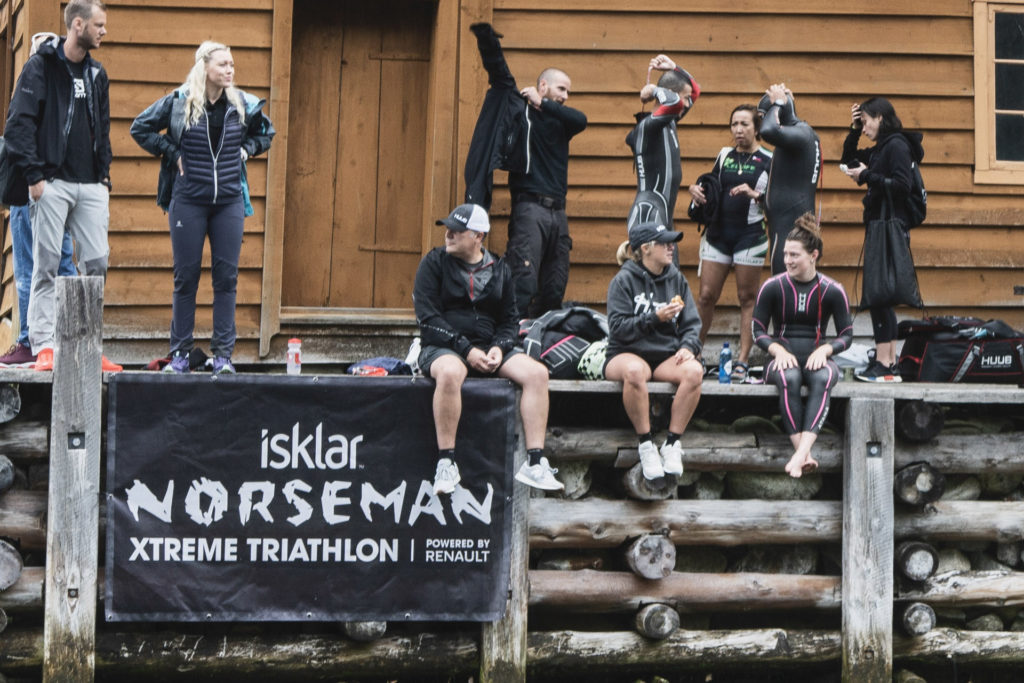
And our financial director went to the race and he came back absolutely gobsmacked at how unique and different it is. And you cannot frame it in any race you’ve done anywhere else in the world. He says it’s so unique and stands alone.
I haven’t done it, Helen. Thanks for rubbing it in that I haven’t been and swam there. I cannot wait to do it. It was going to be planning for this year, but obviously things have changed, but I now have a long, long time to prepare for that. I’m going to need video on my goggles just to truly experience it and be able to go back and remember it.
Helen: Yeah, you’re absolutely right and you have to experience it. I’ve been out to Eidfjord twice before for the last two years races, and it’s just the most breathtaking place in the world for me, to swim. I just adore it. So it is absolutely wonderful. Are there any of the other Xtri World Tour swims that you quite fancy trying as well?
Deano: Personally, no. The thought of being that cold and knowing how much pain I have ahead of me… but it’s my 50th year this year, so I have to lay down some big markers. So you may well be seeing me at a few of them, if I could just shed a bit of my natural insulation.
Helen: We’ll let you off. You spend all your time developing kit for us to use.
Helen: I think we’re all grateful as triathletes to have the team behind Norseman doing all this fantastic work for us, and I’m sure people will be going online and looking at Norseman’s social channels to find out the latest news on your research. So, thank you.
But finally, I think with over a year to train for Norseman 2021 and everyone desperate to get back in that open water as soon as they can, Jørgen, what would your training advice be for competitors as they come out of lockdown?
Jørgen: Well, that’s always a hard question but I would say that it will be a good idea to take it a bit easy, with a whole season, with possibly very few races around. The risk is that too much training is, a possibility for injuries are quite high, because you’re eager and have lots of steam to let out.
I will use the summer to do much more of kind of recreational training, like going for long, slow swims in the ocean near my house, bringing a water bottle, some snacks and my cellphone for making a few selfies and have them in my swim too. Like going for a hike, just in the ocean.
Is there a word for that, by the way, hiking at sea, is that an English word for that?
Deano: New word. Need to invent that one.
Jørgen: Yeah, we need to invent that. I love that. Go hiking at the sea.
Helen: Dean, the same question for you. What’s your training advice for people as we’re able to swim again?
Deano: Well, I think they say every cloud has a silver lining. I think if you want to have your best Norseman ever, or your first Norseman or whatever it may be, you have such a wonderful slow ramp of improving your training load and that’s got to help with injury prevention. It’s got to help you build the most amazing base. And then any sharpeners that you want to build on that, that can be spread out.
Normally you get notified you’re in an event, be it Norseman or London Marathon, it’s suddenly, I’m going to pile everything in and you get injured and you get setbacks. And I think there’s a wonderful very slow run in, and I agree with Jørgen. There’s time to now probably involve friends, family, we know the sport we’re in takes a lot of our time and an immense amount of commitment and it’s a lifestyle because it’s so engrossing.
But there’s opportunities to go for more recreational hiking in the sea activities, take others with you, sharing that and maybe just be a little bit more relaxed about it. I think it also gives you plenty of time to swim in cold waters, and get used to that, and get used to the conditions and get used to going on some lovely weekend breaks and taking some big hilly rides in and maybe do some walking and running up some hills.
And you’ve got such a long time to take separate elements of Norsemen and triathlon, do those extra inversions and be immensely well-prepared for the race.
Helen: I think you’re both absolutely right, and if this has taught us anything, it’s that we’re so lucky to be triathletes and especially open water swimmers. I know from my point of view, I absolutely can’t wait to meet up with my friends that I swim with again, and maybe do some really lazy swimming. Just enjoy being in the lake, tasting that water, seeing the trees, get out again, have some coffee and cake and just enjoy being an open water swimmer again.
But thank you both for your fantastic advise, Jørgen and Dean. It’s a pleasure to talk to you as always. And I hope that everyone watching has learned a lot about how to stay safe and enjoy open water swimming over the next few months.
Helen: Wherever you are in the world, here at Norseman we all wish you the very best and we hope to see you all very soon. Please visit xtriworldtour.com for the latest on all of the races, plus keep checking out our Facebook, Instagram and Twitter feeds for inspiration, motivation, and the best training advice for Xtri athletes.
I’m Helen from 220 Triathlon for Norseman Live. Thank you so much everyone for joining us.
